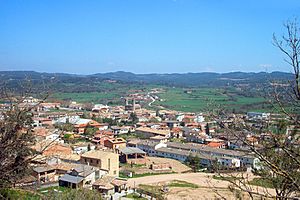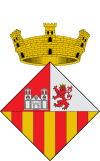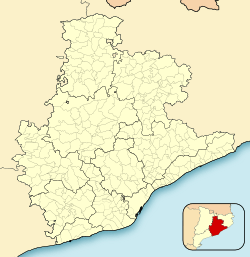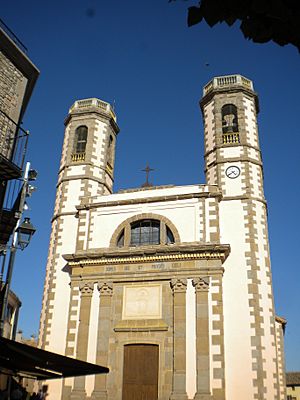Olost facts for kids
Quick facts for kids
Olost
|
|||
|---|---|---|---|
|
Municipality
|
|||

Olost
|
|||
|
|||
| Country | Spain | ||
| Community | Catalonia | ||
| Province | Barcelona | ||
| Comarca | Lluçanès | ||
| Area | |||
| • Total | 29.4 km2 (11.4 sq mi) | ||
| Population
(2018)
|
|||
| • Total | 1,188 | ||
| • Density | 40.41/km2 (104.66/sq mi) | ||
Olost (Catalan pronunciation: [uˈlɔst]) is a small town in the province of Barcelona, Catalonia, Spain. It is home to less than 1,200 people. Olost is located on a flat area, about 669 meters (2,195 feet) above sea level.
The town is about 20 kilometers (12 miles) from Vic. It sits in the middle of the Lluçanès region. Before 2023, it was part of the Osona region.
Contents
Exploring Olost's Landmarks
In the center of Olost, you'll find the impressive Santa Maria d'Olost church. It has a large front and two bell towers. Building this church started way back in the 10th century and finished in the 18th century.
Near Olost, there are two smaller communities. One is Santa Creu de Jutglars, built in 984. The other is Vila, which includes Sant Gil de la Vila, built in 1038.
The Unique Olost Castle
You can also find the unusual Castell d'Olost nearby. It was built in 1155. Later additions were made in the 14th and 15th centuries. This castle is special because it's built in a low area next to a stream. This helped hide it for protection during the Middle Ages. Even though it was a fortified farm, it looks like a real castle.
Sant Adjutori Hermitage
On top of a small hill near the village, there's a small religious building called the hermitage of Sant Adjutori. It was built in 1714.
Olost Through History
During the Middle Ages, Olost was on an important route. Troubadours and "jutglars" (performers like jugglers or musicians) used this road to cross the Pyrenees mountains. This might be how the nearby settlement of Santa Creu de Jutglars got its name.
Some historians believe that the letters "OSS," "SOS," or "OS" in the names of villages in southern France and Catalunya might mean they were influenced by a group called the Cathars. The Cathars were a religious group in the 11th to 13th centuries.
Life in Olost Today
Olost celebrates its village feast on August 15. This day honors its patron saint. The village has a public school for children. There are also two factories.
For transportation, the closest train station is in Vic. From there, a minibus helps people travel to Olost.
Local Products and Farming
The main products grown in Olost are farm goods. These include corn, potatoes, sunflower seeds, and wheat. Nearby farms also raise animals like cows, pigs, and poultry (chickens, ducks, etc.).
Reixach Lake
About 6 kilometers (3.7 miles) from Olost, you'll find an artificial lake and dam called Reixach. It's also known as Santa Creu de Joglars. This lake is on the Gavarresa river. You can reach it by taking the road from Olost towards Prats de Lluçanès. The lake is a good spot for fishing. You might catch small and medium carp or even some northern pike, which were brought there from North America.
Changes in Regional Grouping
In 2015, the people of Olost voted to join a new region called Lluçanès. However, this plan was put on hold because not enough places supported it. Olost was part of the Osona region for a long time. But in 2023, it officially became part of the new Lluçanès comarca (region).
Population Changes Over Time
Here's how the number of people living in Olost has changed over many years:
| 900 | 1515 | 1717 | 1857 | 1900 | 1930 | 1950 | 1970 | 1981 | 1986 | 1990 | 1994 | 1996 | 2006 | 2008 |
|---|---|---|---|---|---|---|---|---|---|---|---|---|---|---|
| -- | 17 | 451 | 1211 | 917 | 1.089 | 1.120 | 904 | 961 | 948 | 969 | 1193 | 1204 | 1187 | 1199 |
See also
 In Spanish: Olost para niños
In Spanish: Olost para niños






